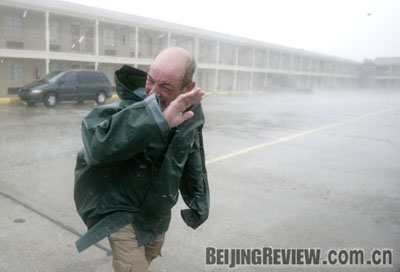|

DEVASTATION: A hotel manager in Morgan City, Louisiana, checks the
damage done by Hurricane Gustav on September 1
This year has seen an unusually active and deadly hurricane season, as storms line up in the Atlantic Ocean to pummel the Caribbean and United States coastline.
The Atlantic hurricane season runs from June 1 to November 30, with August through October the peak months. Three recent hurricanes have killed hundreds in the Caribbean and the United States, both during the storms and in subsequent flooding.
In late August, Hurricane Gustav tore through Haiti, Jamaica and Cuba but weakened by the time it reached the United States a week later. Hurricane Hanna immediately followed, causing severe flooding and mudslides in Haiti. The most recent storm is Hurricane Ike, which hit Cuba twice and was headed toward Texas late last week.
In August, the U.S. National Oceanic and Atmospheric Administration predicted an above-normal hurricane season, upping its season projection to 14 to 18 named storms, including seven to 10 hurricanes and three to six major hurricanes. An average Atlantic hurricane season has 11 named storms, six hurricanes and two major hurricanes.
Haiti, one of the poorest countries in the Western Hemisphere, has had the most difficulty recovering. Residents returning to their homes and businesses waded through waist-high water after Hurricane Ike passed through on September 7. The resulting damage to roads and bridges has made it difficult for aid workers to reach the hardest-hit areas. The three hurricanes and a smaller tropical storm have killed more than 600 Haitians since August 15, with police officers burying bodies before they could be fully identified. The United Nations reported 800,000 people in temporary shelters.
Learning from history
Hurricane Gustav made landfall in Louisiana on September 1, almost exactly three years to the day after Hurricane Katrina devastated the region. With $81 billion in damage, Katrina was the costliest natural disaster in American history. Much of the death and destruction, however, occurred in New Orleans, Louisiana, after Katrina had passed. The storm surge overwhelmed the levees surrounding the city, and within two days New Orleans was 80 percent under water.
Although the vast majority of people had left, many poor and elderly residents were unable to evacuate and were trapped in their homes. Americans watching TV were horrified to see bodies lying in the street and 20,000 survivors crowded into a football stadium with no water and rampant crime.
| 